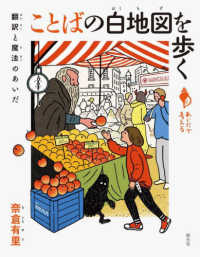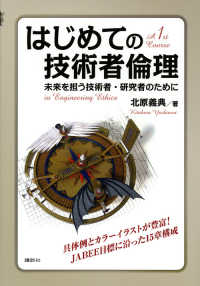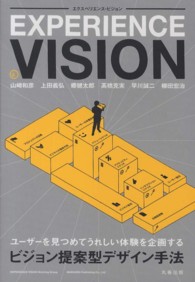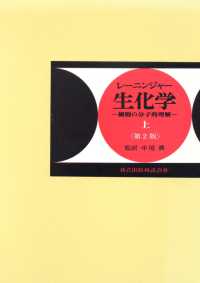Full Description
Snapshots and Soundbites of Korean Culture takes a novel approach to understanding Korea's past and present by blending sounds, imagery, texts, and online and printed materials to provide a multi-sensory, multi-modal experience of Korean culture.
Each entry showcases vitally important objects, places, events, institutions and people that help us conceptualise Korean history, society and culture. The volume comprises short, transcribed lectures on specific aspects of Korean culture, accompanied by explanatory notes, images, and links to a specially prepared website featuring voice recordings, additional images, and class-ready teaching resources. Contributors to the volume include some of the most respected researchers in Korean Studies, such as Martina Deuchler, Don Baker, Chan E. Park, Vladimir Tikhonov, John Duncan, and Park Tae-gyun, alongside emerging scholars. Each entry is written in an accessible style, making the book appealing to scholars, Korean Studies students, and readers with a general interest in Korea. The variety of topics examined includes iconic objects (ondol), important historical characters (Yun Sŏn-do, Pak Hŏn-yŏng), central events (the 1637 Qing Invasion and the 1980 Kwangju Uprising) and vital beliefs (shamanism) - all of which help us conceptualise what has made Korea the place it is.
Additional resources can be found at snapshotssoundbites.wordpress.com .
The text serves as an academic study, a reference work, a book for leisurely reading or as a primer for university-level Korean Studies survey courses.
Contents
Section 1: Art and Culture
(i) Fine Art
Fine Art Introduction
1. Green-glazed Celadon Ceramics of the Koryŏ Period
2. Japanese Depictions of Music among Korean Envoys (the Chōsen shisetsu gyōretsu zukan, 1655?)
(ii) Songs and Music
Songs and Music Introduction
3. Pansori, An Intercultural History of Korean Story-Singing
4. How to Count Korean Rhythm
5. Transcending Multiple Borders: Korean Performing Arts and Artists in the Early Twentieth Century
6. The 1990s Arrival of Punk Rock in Korea
(iii) Performance and Theatres
Performance and Theatres Introduction
7. Mask Dance Dramas (kosŏng Ogwangdae)
8. The Seoul Drama Center
9. Madanggŭk (People's Theatre and Taehangno Theatre District, Seoul)
Popular Culture in the Two Koreas
(iv) Popular Culture in the Two Koreas: South Korea
South Korean Popular Culture Introduction
10. On the Movie Shiri (dir: Kang Je-gyu, 1999)
11. On Hand-painted Cinema Billboards in South Korean Cities
12. K-dramas that Hurt and Heal
(v) Popular Culture in the Two Koreas: North Korea
Introduction
13. Shin Sang-ok and the New Wave of North Korean Cinema
14. North Korean Graphic Novels about the Korean War
Section 2: Religion, Philosophy, Thought and Texts
(i) Shamanism
Shamanism Introduction
15. Muga - the Songs of the Shaman
16. Pari Kongju (Princess Pari, the First Shaman)
(ii) Buddhism
Buddhism Introduction
17. The Korean Buddhist Canon: the Koryŏ Taejanggyŏng
18. The Chikchi and Its Global Impact
19. Kwanseŭm - the Boddhisatva of Compassion
20. Toksŏng- the Mysterious Lonely Saint in Korea's Buddhist Monasteries
21. Chŏng Yak-yŏng and Buddhism
(iii) Confucianism
Confucianism Introduction
22. Confucianism During Chosŏn Period Korea
23. Korean Genealogy (Chokpo)
24. Chosŏn Dynasty Funerary Tablets (Myojimyŏng)
(iv) Christianity
Christianity Introduction
25. On the Translation of the Bible into Korean
26. The Ilsin Women's Hospital
(v) Communism
Communism Introduction
27. On the Politician, Pak Hŏn-yŏng (1900-1956)
(vi) Nationalism
Nationalism Introduction
28. On Pre-modern Korean Identity
29. Personality Cults Past and Present
(vii) Authors, Texts and Books
Authors, Texts and Books Introduction
30. On the Ten Injunctions (Hunyo sipcho) of the Koryŏ Dynasty
31. The Poet, Philosopher and Politician, Yun Sŏn-do
32. The Chosŏn Dynasty text, Chŏnggamnok (the records of Chŏnggam)
33. The Sim Wŏn-gwŏn ilgi (Sim Wŏn'gwŏn ilgi)
34. Pak T'ae-wŏn's Novel: A Day in Life of Kubo, the Novelist, as a Representative Korean Modernist Novel
35. Children's Literature
Section 3: Korean Places, Spaces, Pastimes, Food and Language
(i) Korean Places and Spaces
Korean Places and Spaces Introduction
36. The Diving Women of Chejudo, Haenyŏ
37. The Kumŏng Kage (Old style corner shops)
38. Korean Bathing Culture: Spaces for Social Communication and Cultural Identity
39. Ondol/kudŭl, the Korean Underfloor Heating System
(ii) Education
Education Introduction
40. Sunŭng (The South Korean College Entrance Exam)
(iii) Korean Sports and Pastimes
Korean Sports and Pastimes Introduction
41. A Brief Historical Account of the General Evolution of Taekwondo
(iv) Nutrition
Nutrition Introduction
42. Korean Ginseng
43. The Chilli in Korea
44. Sinsŏllo - a Forgotten Treasure of Korean Cuisine
(v) Language
Language Introduction
45. On Sinographs (Chinese Characters Used in the Korean Language)
46. On the Invention of Hangul
47. The Other Uses of the Korean Alphabet: Foreign Language Learning in Pre-modern Korea
48. On the Publication of Korea's First Unabridged Monolingual Dictionary (Chosŏnmal k'ŭn sajŏn)
49. Honorifics, Politeness and Social Change
Section 4: Social, Political and Historical Developments
(i) Social change
Social change Introduction
50. Early Korean Migrants to Hawai`i
51. The Meaning of Multiculturalism (tamunhwa) in South Korea
52. Markets and North Korean Women, 2015
Political and Historical change
(ii) Invasions
Invasions Introduction
53. Waegu (Japanese pirates), 1350 to 1419
54. The Court Debate Over the 1637 Qing Invasion
(iii) Factionalism in Chosŏn
Factionalism in Chosŏn Introduction
55. Political Factionalism in Chosŏn Korea
(iv) The Korean War and the Vietnam War
The Korean War and the Vietnam War Introduction
56. On the POW Issue During the Korean War
57. On the 1954 US-ROK Status of Forces Agreement
58. South Korean Participation in the Vietnam War
(v) Democratisation and Protest
Democratisation and Protest Introduction
59. On the Kwangju Uprising, 1980
60. On the 1987 Seoul Demonstrations (the June Uprising)
61. On the 1987 Constitutional Reforms
62. The Student Movement of the 1990s
(vi) Historical Controversies
Historical Controversies Introduction
63. The Koguryŏ Controversy and Korea's 'Shared History' with China
Index








